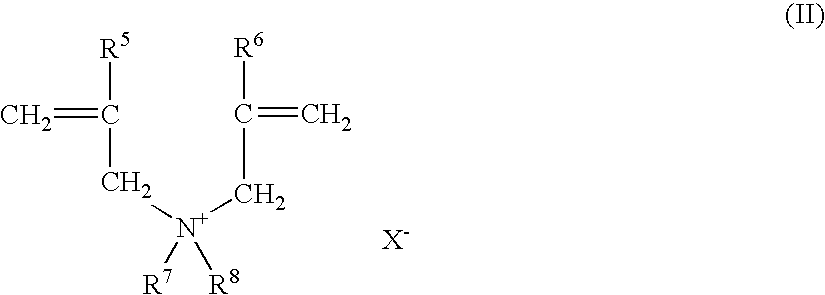Treatment composition for textile products
a technology for textile products and compositions, applied in detergent compositions, detergent compounding agents, coatings, etc., can solve the problems of affecting the quality of textile products, and affecting the appearance of textile products,
- Summary
- Abstract
- Description
- Claims
- Application Information
AI Technical Summary
Problems solved by technology
Method used
Image
Examples
synthesis example 1
[0099]0.55 part of RYOTO Sugar Ester S-770 (manufactured by Mitsubishi-Kagaku Foods Corporation) was dissolved in 479.8 parts of cyclohexane. To this solution was added an aqueous solution prepared by dissolving 13.8 parts (75% aqueous solution) of a dimethylaminopropylacrylamide quaternary salt (DMAPAA-Q manufactured by Kohjin Co., Ltd.), 44.7 parts of N,N-dimethylacrylamide (manufactured by Kohjin Co., Ltd.), and 0.679 part of 2,2′-azobis(2-amidinopropane) dihydrochloride as a polymerization initiator in 75.43 parts of deionized water. The mixture was dispersed with a homomixer until the particle size of the aqueous phase was reduced to 3 to 4 μm. The resulting dispersion was placed in a 2 L separable flask equipped with a stirrer, a thermometer, a nitrogen inlet tube and a reflux condenser, and then the atmosphere in the reaction container was replaced by nitrogen, followed by increasing the temperature of the flask on a bath set at a temperature of 54° C. The internal temperatur...
synthesis example 2
[0100]0.55 part of RYOTO-Sugar Ester S-770 (manufactured by Mitsubishi-Kagaku Foods Corporation) was dissolved in 479.8 parts of cyclohexane. To this solution was added an aqueous solution prepared by dissolving 13.8 parts (75% aqueous solution) of a dimethylaminopropylacrylamide quaternary salt (DMAPAA-Q manufactured by Kohjin Co., Ltd.), 44.7 parts of N,N-dimethylacrylamide (manufactured by Kohjin Co., Ltd.), 0.0074 part of polyethylene glycol dimethacrylate (NK-14G manufactured by Shin-Nakamura Chemical Co., Ltd.), and 0.679 part of 2,2′-azobis(2-amidinopropane)dihydrochloride as a polymerization initiator in 75.43 parts of deionized water. The mixture was dispersed with a homomixer until the particle size of the aqueous phase was reduced to 3 to 4 μm. The resulting dispersion was placed in a 2 L separable flask equipped with a stirrer, a thermometer, a nitrogen inlet tube and a reflux condenser, and then the atmosphere in the reaction container was replaced by nitrogen, followed...
synthesis example 3
[0101]A polymerization product was obtained in the same manner as in Synthesis Example 2 except that under the production conditions in Synthesis Example 2, the amount of the polymerization initiator was the same, and only the amount of the crosslinking agent was changed to 0.018 part.
PUM
| Property | Measurement | Unit |
|---|---|---|
| pH | aaaaa | aaaaa |
| temperatures | aaaaa | aaaaa |
| reaction time | aaaaa | aaaaa |
Abstract
Description
Claims
Application Information
 Login to View More
Login to View More - R&D
- Intellectual Property
- Life Sciences
- Materials
- Tech Scout
- Unparalleled Data Quality
- Higher Quality Content
- 60% Fewer Hallucinations
Browse by: Latest US Patents, China's latest patents, Technical Efficacy Thesaurus, Application Domain, Technology Topic, Popular Technical Reports.
© 2025 PatSnap. All rights reserved.Legal|Privacy policy|Modern Slavery Act Transparency Statement|Sitemap|About US| Contact US: help@patsnap.com



